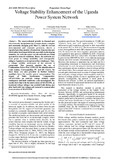| dc.description.abstract | The unprecedented growth in demand and drive towards deregulation has brought about a complex and constantly changing grid. More so, with the current environmental and economic pressures, there's a reported growing number of numerous transmission and distribution investment deferrals, especially in developing countries. As such, the power system networks are being operated in stressed conditions. Hence, the networks are more prone to voltage instability, and consequently, collapse. Uganda is no exception to these challenges. Thus, a voltage stability assessment of the network is paramount. This research employs the use of Continuation Power Flow (CPF) for the identification of weak regions. Corresponding PV and QV Curves for these buses are also provided to further buttress candidate buses for reactive power compensation. The impact of Static Synchronous Compensators (STATCOMs) on network voltage stability under contingency and fault conditions is also investigated. The results show that with the intervention of STATCOM, an imminent voltage collapse was avoided both during and after fault with bus voltages all restored to normal after incorporation of STATCOM. | en_US |

